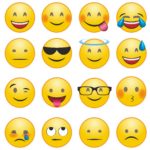 Emojis are an enduringly popular way to express emotions in what can often be emotionless textual conversations. They may seem a benign and harmless way to do that, but new research from the University of Alabama suggests they may be underpinning cultural ideologies about race.
Emojis are an enduringly popular way to express emotions in what can often be emotionless textual conversations. They may seem a benign and harmless way to do that, but new research from the University of Alabama suggests they may be underpinning cultural ideologies about race.
“It’s a fallacy that tech is raceless, though it is often perceived as such,” the researchers say. “For a lot of our technologies there is an ideal user imagined, and these skin-tone modifiers created a moment of rupture for those users—in this case, white people—who suddenly were made aware of race in an interface that had previously seemed raceless to them.”
Supporting communication
The researchers conducted a number of experiments to modify the skin-tone of emojis and understand how that influenced the conversations between people.
“How we interpret our technologies and how we design them are all reflective of the particular cultural context we live in,” the researchers explain. “Emoji are a lens through which we can see how gender, race and power shape all of the technological structures around us.”
Emojis have become an official part of the Unicode Standard since 2010, although they have been in operation since their introduction in 1999. The early versions of emojis had a light skin tone, which attracted sufficient criticism that they were quickly changed to a yellow color more akin to that of the traditional smiley face icon.
This usage of a neutral skin tone was altered in 2015 to apply a wider range of human skin colors that were based upon a dermatological scale of skin tones. The tech companies that make up the Unicode Consortium believed this approach allowed for race representation in a race-neutral way, but the research suggests otherwise.
“In fact, the skin tone modifiers raised more questions about race and representation among both white and BIPOC (Black, Indigenous and people of color) emoji users,” they say. “The skin-tone modifiers were overlaid on top of the base emoji characters, rather than rethinking the design of the whole thing. Because of this, elements of whiteness remained intact.”
Suffice to say, it’s a situation that is evolving each year, as emoji are released with different hair textures, genders, eye color, and even non-binary emoji. It’s an attempt by Unicode to better represent our diverse culture, but the researchers believe these efforts are insufficient to address the underlying power structure of mass communication systems.
“It’s a matter of who calls the shots and how that plays out in coding,” they conclude. “We can dress up the surface, but we’ve never really unpacked how different kinds of social, political and cultural arrangements are embedded deep in the bones of emoji as a technology. Asking these questions helps us see the reaches of power in our everyday practices.”